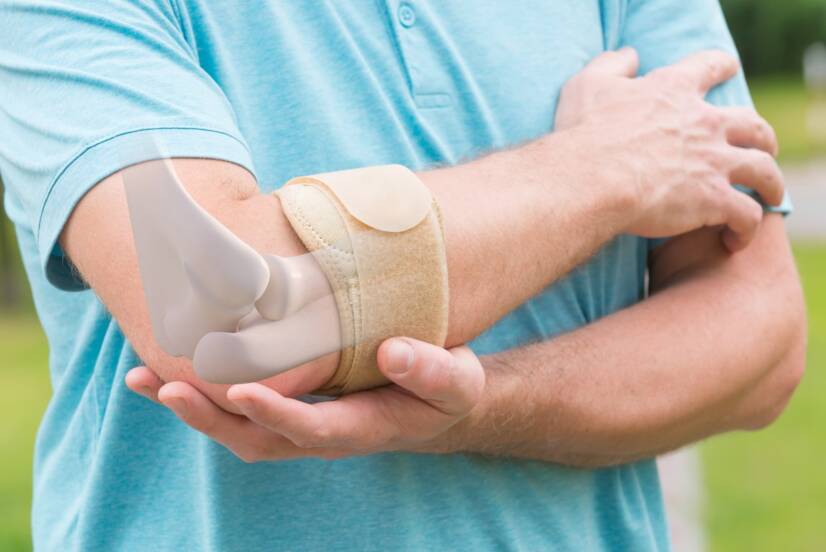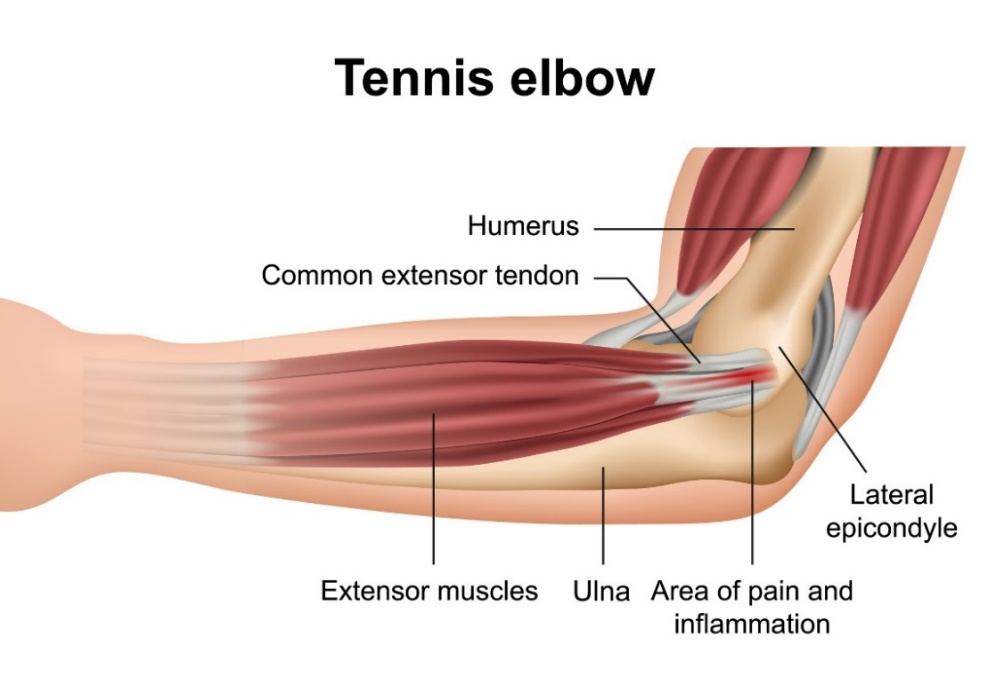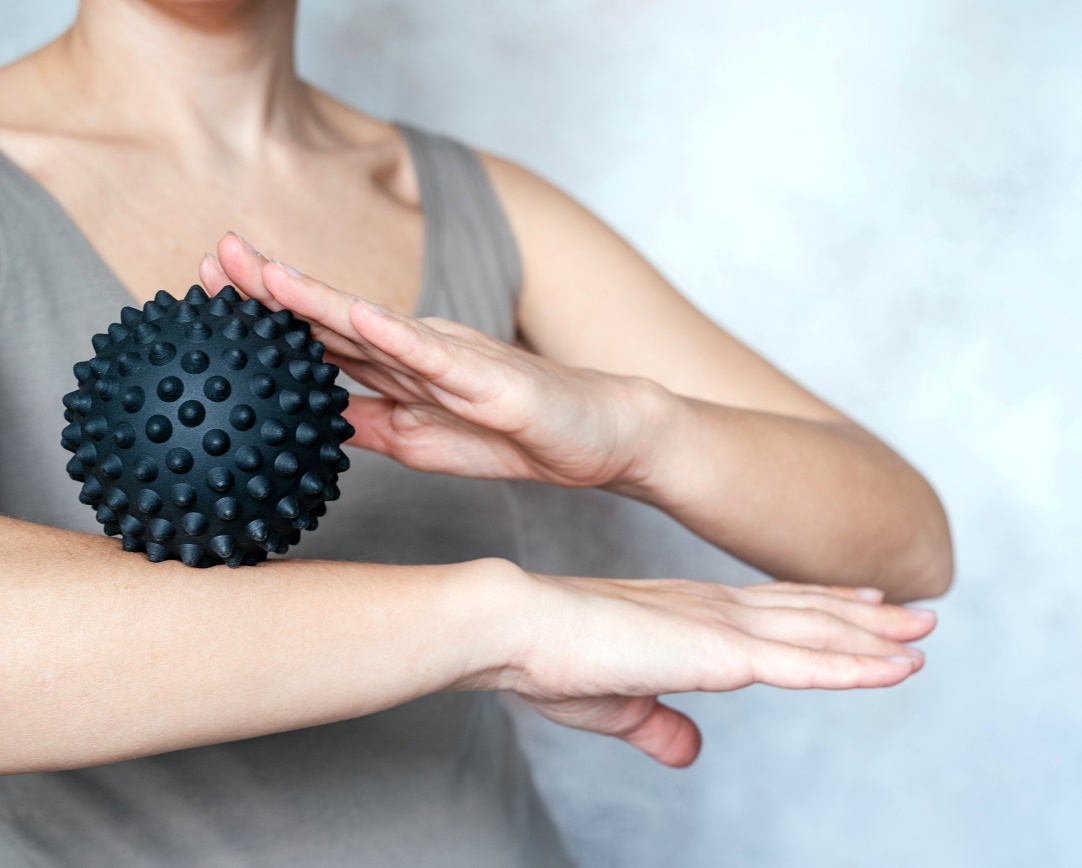- solen.sk - Lateral epicondylitis is a chronic enthesopathy affecting not only athletes. MUDr. Peter Polan, PhD, MPH , MUDr. Jozef Kubasovský , PhDr. Peter Hermel
- is.muni.cz - Problems of tennis and javelin elbow. Faculty of Sports Studies Department of Physical Medicine and Health Physical Education. Masaryk University. Jana Fraňková, DiS Bachelor thesis supervisor. Mgr. lenka Beránková, Ph.d.
- Pubmed.ncbi.nlm.nih.gov - Lateral and medial epicondylitis of the elbow. J Am Acad Orthop Surg.
- Physio-pedia.com - Lateral epicondylitis of the elbow.
- orthoinfo.aaos.org - Tennis elbow (lateral epicondylitis).
Tennis elbow: causes and symptoms? + Home exercises and prevention

Excessively painful elbow tendonitis is a common problem, especially in people with stereotypical manual work. Lateral epicondylitis is also a common problem in professional athletes. What is the cause and treatment of tennis elbow syndrome?
Most common symptoms
- Joint Pain
- Muscle Pain
- Pain that Radiates into the Shoulder
- Increased body temperature
- Shooting pain in fingers and toes
Characteristics
Lateral (radial) epicondylitis, popularly known as tennis elbow, is a common condition not only in professional athletes. It is one of the most common tendonitis (enthesopathy) in the human musculoskeletal system.
It is a tendon disorder arising as a result of overloading of the forearm muscles.
It was first described professionally in 1873 as scribes' pain. It was subsequently associated with tennis. However, lateral epicondylitis occurs in a wider range of sports such as badminton, athletics and basketball.
The diagnosis is also often found in musicians playing stringed instruments, people working on computers and people with manual jobs. Most often, it involves unilateral loading of the upper limb without sufficient compensation for the opposite movement.
Anatomy and kinesiology of the elbow joint
The elbow joint (articulatio cubit) is a compound joint made up of three bones - the humerus, ulna and radius. The joint between the humerus and ulna provides flexion and extension of the forearm of the upper limb.
The joint between the ulna and radius provides rotation of the forearm and wrist - downward and upward rotation of the hand.
At the end of the humerus are two lateral anatomical processes called epicondyles. Lateral epicondylitis occurs on the outer epicondyle (process) of the radius.
Directly in the area of the lateral process are the stressed muscles of the forearm performing extension of the wrist and fingers (flexion of the hand and fingers in a dorsal direction), movement of the wrist behind the thumb, and the actual rotation of the forearm with the wrist.

Clinical findings include enthesopathy (tendonitis) of the muscles of the wrist and fingers of the hand arising from the region of the outer epicondyle of the humerus.
The musculus extenzor carpi radialis brevis is most commonly affected and less commonly the musculus extenzor digitorum communis. These are the muscles on the thumb side of the forearm.
In the area of the tendons of the muscles, a violation of the structure of collagen fibres can be found.
Damage to the tendons results in impaired muscle mobility, locking of the joint and impaired synovial (joint) fluid exchange. This can cause alteration of the articular cartilage and the development of osteoarthritis.
Causes
The underlying cause of tennis elbow is inflammation of the muscle attachment to the bone - the tendon. There is an inflammatory process and the formation of micro tears along the muscle tendon fibre.
The cause of inflammation is acute or chronic overloading of the extensor muscle group of the forearm.
The opposite is medial epicondylitis, when the attachment of the opposite muscle group, i.e. the flexors of the forearm, is disturbed. The inner epicondyle of the humerus, on the other hand, is painful.
The acute form of tennis elbow syndrome arises mainly after strenuous physical activity and improper movement with higher demands than the muscle can handle at the time.
The chronic form is diagnosed when there is prolonged discomfort and pain. It is caused by prolonged excessive and gradual loading of the extensor muscles of the forearm. It usually involves stereotyped repetitive movements.
Increased incidence of tennis elbow syndrome is mainly observed in athletes who engage the upper limbs during movement.
These are mainly sports that are characterized by unilateral overloading, such as tennis, table tennis, basketball, badminton, athletics and others.
The aetiology of lateral epicondylitis is also risky in people with manual occupations, where there is a stereotyped repetitive movement of the upper limb and forearm.
This includes occupations such as carpenter, repairman, cook, painter, typist or occupations with work on computers and computer mouse.
Common causes:
- Excessive muscle strain
- Mechanical damage
- Manual work of the upper limbs
- Same repetitive movements
- Working on a computer
- Playing a musical instrument
- Sports activity
Symptoms
The first symptom is localised pain in the elbow area during heavy exertion and movement. In the later stages of the disease, it is possible to feel pain during normal daily physical activities.
Supination and pronation movements of the arm (rotational movements of the forearm) are the most painful. Pain may also occur with touch and pressure when the limb is resting on the elbow.
When the muscle is overloaded, muscle spasms (stiff painful fibres) and trigger points - painful irritation points in the muscle fibre - can occur. Pain can be localised both in the wrist and over the muscles of the dorsal side of the hand.
Difficult, restricted or uncoordinated movement of the forearm and wrist of the upper limb may also be present.
Most common symptoms:
- Pain in the elbow joint area
- Soreness on the outside of the elbow
- Dull pain over the muscles
- Pain when moving the forearm
- Pain on touch and pressure
- Restricted movement of the forearm and hand
- Shortening of forearm muscles
- Impaired motor skills and muscle coordination
Diagnostics
During the examination, the patient's medical history is taken. The doctor focuses on the area of work and leisure, kinesiological analysis in the sense of examination by aspect (gaze) and palpation.
The mobility and reflex reactions of the soft tissues - skin, subcutaneous tissue, fascia and musculature - are assessed. The elbow joint freedom, movement, range, pain and temperature are evaluated.
As part of the diagnosis, an X-ray or magnetic resonance imaging (MRI) is indicated to rule out osteoarthritis, degenerative cartilage process and other joint diagnoses.
Prevention of tennis elbow
The prevention of epicondylitis is the elimination of prolonged stereotyped movement in the wrist and forearm.
In manual work and professional sports, regular movement compensation activity of the opposite muscle group and consistent regeneration of the stressed limb is necessary.
For regular home relaxation of the strained muscles of the upper forearm, massage with a massage hedgehog or ball is suitable.
The use of a kinesiotape, elastic fixation brace and over-the-counter topical supplements for the health of muscle and joint structures in the form of a gel or a patch are suitable.

Exercises for tennis elbow
Exercises to relax the wrist against a wall
Place the palms of the hands in front of you on a wall with the fingers of the hand pointing down. The wrist is at right angle. Try to push into the wall with the body and straight upper limbs, while decreasing the right angle by stretching the muscles in the wrist.
Hold for 30 seconds and then rotate the hands to stretch the muscles of the upper and lower forearm and wrist. Repeat the exercise at least 3 times in a row. Breathing is natural and regular.
Isolated relaxation of the tennis elbow muscles
Bend the affected limb at the elbow to maximum flexion with the palm of the hand facing the biceps. Squeeze the fingers of the affected limb from above with the healthy hand to stretch and tense the extensor muscles of the forearm and wrist.
Hold for 30 seconds and release. Repeat 3-5 times in succession. Do not hold your breath.
Elbow joint rotation exercise
On all fours, tense the upper limbs at the elbows and press the palms of the hands into the mat beneath you. The fingers of the hands point forward. The back is straight and the head in extension of the spine.
The goal of the isolated rotational movement at the elbows while locking the palms is to achieve centered joint position and balance between the flexor and extensor muscles of the forearm.
Relaxation of the forearm muscles using a ball or roller
Rest the affected limb with the entire back of the forearm on a mat/table. The palm of the hand is facing upwards towards the ceiling. The arm is relaxed.
Place a massage ball or roller between the muscles of the forearm and the mat, which is moved by pressure and sideways movement of the forearm. Pressure-controlled massage of the stressed muscles takes place.
Relaxing the forearm muscles with the massage hedgehog
The strained upper limb is placed comfortably on the table. The back of the hand points upwards. The arm is naturally relaxed.
Grasp the massage hedgehog with your good hand and run it over the stiff muscle fibres of the affected limb. You can control the painfulness of the massage by applying your own pressure.
Visualisation of the onset of lateral epicondylitis - video
(Video source: Youtube. 3D4 Medical by Elsevier)
How it is treated: Tennis elbow
Treatment of tennis elbow: medications, tapes, braces, rehabilitation and other preparations
Show moreTennis elbow is treated by
Other names
Interesting resources










